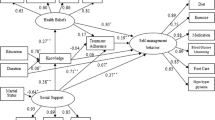Abstract
Background
Values influence social activities and social decisions, but the interaction of values and health outcomes (HO), which are of increasing importance for evidence-based medicine and public health decisions, has not been analysed so far and was the objective of this study.
Aim
This case study used the social value scale which assigns individual human beings into stable and clearly separated value orientation (VO) groups. For the first time an attempt was made to investigate the VO and the HO of patients and relate them to different aspects of their diabetic complications neuropathy or retinopathy, disease patterns with a wide range of disease burden ranging from minor symptoms to severe burden such as blindness or amputation.
Results
Physician visits, costs and the physical component health-related quality of life (HRQL) were highly dependent on the complication type, with retinopathy patients having fewer visits at the treating physician, more visits at other physicians, lower costs from the GKV (gesetzliche Krankenkasse = compulsory health insurance fund) and societal perspectives, and a higher physical HRQL. In contrast, the amount of glycosylated haemoglobin (HbA1c) and the mental component HRQL were significantly influenced by the VO: active Realists, who comprised the largest VO group among the patients with diabetic complications, exhibited the lowest HbA1c and accounted for the highest percentage of working patients, indicating that they manage their disease more efficiently than other VO groups. In the retinopathy sample the active realists also had the highest mental HRQL. In contrast, the conventionalists had the smallest proportion of working patients and exhibited the highest HbA1c, indicating that they did not manage their disease effectively; in the retinopathy sample, the conventionalists had the lowest mental HRQL.
Conclusion
Thus, values might influence both individual treatment decisions and the perception of the disease in general and could thus provide additional insight into future investigations of HO.



Similar content being viewed by others
References
Happich M, Breitscheidel L, Meisinger C, Ulbig M, Falkenstein P, Benter U, Watkins J (2007) Cross-sectional analysis of adult diabetes type 1 and type 2 patients with diabetic microvascular complications from a German retrospective observational study. Curr Med Res Opin 23:1367–1374
Happich M, Reitberger U, Breitscheidel L, Ulbig M, Watkins J (2008) The economic burden of diabetic retinopathy in Germany in 2002. Graefes Arch Clin Exp Ophthalmol 246:151–159
Hauner H, Köster I, von Ferber L (2003) Prävalenz des Diabetes mellitus in Deutschland 1998–2001. Sekundärdatenanalyse einer Versichertenstichprobe der AOK Hessen/KV Hessen. Dtsch Med Wochenschr 128:2632–2637
Hippler HJ, Schwarz N, Sudman S (1987) Social information processing and survey methodology. Recent research in psychology. Springer, Berlin
Inglehart R (1977) The silent revolution. Changing values and political styles among Western publics. Princeton University Press, Princeton
Inglehart R, Welzel CH (2005) Modernization, cultural change and democracy. The human development sequence. Cambridge University Press, New York
Inglehart R, Basanez M, Moreno A (2004) Human values and beliefs. A cross-cultural sourcebook. University of Michigan Press, Ann Arbor
Klages H (1988) Wertedynamik. Über die Wandelbarkeit des Selbstverständlichen. Edition Interfrom, Zürich
Klages H, Hippler G (1993) Mitarbeitermotivation als Modernisierungsperspektive. Ergebnisse eines Forschungsprojektes, 2nd edn. Verlag Bertelsmann Stiftung, Gütersloh
Klages H, Hippler HJ, Herbert W (1992) Werte und Wandel: Ergebnisse und Methoden einer Forschungstradition. Campus Verlag, Frankfurt/Main
Lehnert H, Wittchen HU, Pittrow D, Bramlage P, Kirch W, Böhler S, Höfler M, Ritz E (2005) Prävalenz und Pharmakotherapie des Diabetes in der primärärztlichen Versorgung. Dtsch Med Wochenschr 130:323–328
Liebl A, Neiss A, Spannheimer A, Reitberger U, Wagner T, Görtz A (2001) Kosten des Typ-2-Diabetes in Deutschland. Dtsch Med Wochenschr 126:585–589
Mundenbruch R, Bechtold R (2001) Gegenüberstellung mit Abrechnungshinweisen. Zauner Druck-und Verlags GmbH, Dauchau
Rote Liste Service GmbH (2002) Editio Cantor Verlag für Medizin und Naturwissenschaften GmbH, Aulendorf
Schwabe U, Paffrath D (2002) Arzneiverordnungsreport: Aktuelle Daten, Kosten, Trends und Kommentare. Springer, Berlin
Verband deutscher Rentenversicherungsträger, VDR (2003) Gesundheitsberichterstattung des Bundes: Gesetzliche Rentenversicherung. Informationsreihe Rentenversicherung, LVA Rheinprovinz Düsseldorf
Ware JE, Kosinski M, Turner-Bowker DM, Gandek B (2002) How to score version 2 of the SF-12-v2 Health Survey. QualityMetric Incorporated, Lincoln
Wilkinson CP, Ferris FL, Klein RE, Lee PP, Agardh CD, Davis M, Dills D, Kampik A, Pararajasegaram R, Verdaguer JT (2003) Proposed international clinical diabetic retinopathy and diabetic macular edema disease severity scales. Ophthalmology 110:1677–1682
http://www.ddz.uni-duesseldorf.de (2007) German Diabetes Center. Incidence of diabetes mellitus. Last accessed Aug 2007
http://www.who.int/diabetes/facts/world_figures/en (2007) World Health Organization. Country and regional data. Last accessed Aug 2007
Acknowledgements
This work was supported by Lilly Germany GmbH, Bad Homburg.
Conflict of interest statement
The authors confirm that there are no relevant associations that might pose a conflict of interest.
Author information
Authors and Affiliations
Corresponding author
Rights and permissions
About this article
Cite this article
Clouth, J., Reips, M., Eichmann, F. et al. Health outcomes and value orientation—a case study in diabetic patients with retinopathy or neuropathy. J Public Health 16, 309–316 (2008). https://doi.org/10.1007/s10389-007-0177-2
Received:
Accepted:
Published:
Issue Date:
DOI: https://doi.org/10.1007/s10389-007-0177-2




